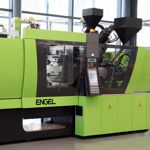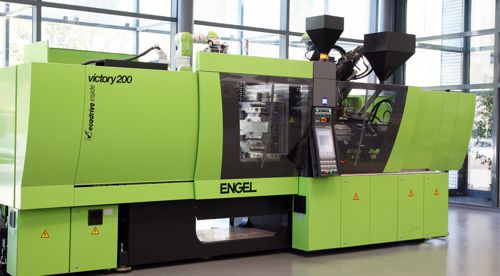
Modellierung und Regelung von Spritzgießmaschinen
Projektschwerpunkte
- Modellbasierter Entwurf von optimalen Regelungsstrategien für die Einspritz- und Nachdruckphase
- Modellbasierte Regelung der Temperaturverteilung in der Spritzgießmaschine
- Anwendung für Spritzgießmaschinen mit hydraulischem Direktantrieb
Beschreibung
Spritzgießen ist das am weitesten verbreitete Produktionsverfahren zum Erzeugen von Bauteilen aus Kunststoff. Dabei wird Kunststoffgranulat in einer Spritzgießmaschine durch Erwärmung und Deformation mit Hilfe einer Förderschnecke verflüssigt. Der flüssige Kunststoff sammelt sich im Schneckenvorraum. Wird die Schnecke nach vorne bewegt, so fließt der flüssige Kunststoff aus dem Schneckenvorraum und die Form wird gefüllt. Wenn der Kunststoff in der Form hinreichend abgekühlt ist, dann kann das fertige Kunststoffteil entnommen werden und der Prozess beginnt von vorne.

Foto einer Spritzgießmaschine
Eine wesentliche Grundlage zur Gewährleistung einer gleichmäßig hohen Produktqualität ist eine hohe Stabilität des Einspritzprozesses von einem Einspritzvorgang zum nächsten. Die wesentlichen Prozessgrößen sind hierbei die Temperaturen, die Einspritzgeschwindigkeiten sowie die Einspritzdrücke. Um diese Prozessgrößen möglichst genau und reproduzierbar vorzugeben, sind geeignete Regelungsstrategien notwendig. In dieser Forschungskooperation mit der Firma Engel werden optimale Regelungsstrategien für die Einspritzregelung (Geschwindigkeit, Druck) sowie die Temperaturregelung für Spritzgießmaschinen entwickelt. Ein Schwerpunkt liegt dabei auf hydraulisch aktuierten Spritzgießmaschinen mit Direktantrieb (Servopumpe), die sich durch eine verbesserte energetische Effizienz im Vergleich zu hydraulischen Spritzgießmaschinen mit Ventilsteuerung auszeichnen. Die Regelung für diese Bauform von Spritzgießmaschinen wird jedoch dadurch erschwert, dass die Dynamik der Aktorik wesentlich geringer ist.
Projektpartner
Ansprechpartner
Univ.Prof. Dr.-Ing. Wolfgang KemmetmüllerUniv.-Prof. Dr.techn. Andreas Kugi